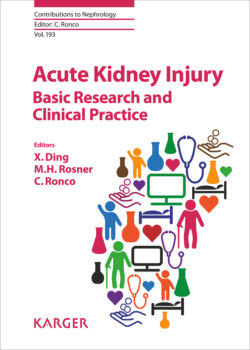Читать книгу Acute Kidney Injury - Basic Research and Clinical Practice - Группа авторов - Страница 7
На сайте Литреса книга снята с продажи.
Preface
ОглавлениеThis new volume in the series Contributions to Nephrology is fully dedicated to acute kidney injury (AKI). The book has been developed in conjunction with the Shanghai Spring AKI Forum where many of these critical topics will be discussed in a collaborative forum that brings experts from across the world together.
AKI is a complex syndrome that is a significant burden among hospitalized patients. In recent years, there has been an increase in AKI events due to the increased susceptibility of fragile and elderly subjects and the increase in significant and potentially nephrotoxic exposures. The latter include advanced surgery (especially complex cardiovascular surgery, imaging techniques, and nephrotoxic drugs). Recently, a plethora of new chemotherapeutic agents has become important causes of AKI in patients with cancer.
The structure of the book is designed to offer the reader recent advances in the field of AKI in different settings. First, there is a reappraisal of the current definitions and staging classifications for AKI available in the literature. This is followed by a description of new criteria to identify patients at risk and characterize early kidney insult by biomarkers. The use of biomarkers other than urine output and serum creatinine for diagnosis and risk assessment of AKI has the hope of revolutionizing aspects of the care of patients. Other important aspects discussed in this book include the sequelae of AKI (most importantly the development of chronic kidney disease) and AKI in special populations such as children, the elderly and those with cancer (a field termed “onconephrology”).
Finally, AKI is a syndrome with consequences that affect not only patient outcomes but also healthcare expenditures. This volume addresses these critical topics from several perspectives including the use of electronic medical records to link practice patterns and outcomes and the use of precision medicine to target AKI therapies to specific phenotypes and genotypes based upon techniques to define pathogenesis and the financial burden of AKI. In addition, quality measures should be identified and the ratio between cost and benefit of different therapies should be carefully analyzed.
AKI is a complicated field that requires the intervention of different specialists who combine their knowledge to optimize outcomes. For this reason, this book is a perfect tool not only for nephrologists but also for every specialist who wishes to become acquainted with this complex syndrome and aims to participate in the multifaceted endeavor to improve care and outcomes in these patients.
Xiaoqiang Ding, Shanghai
Mitchell H. Rosner, Charlottesville, VA
Claudio Ronco, Vicenza
